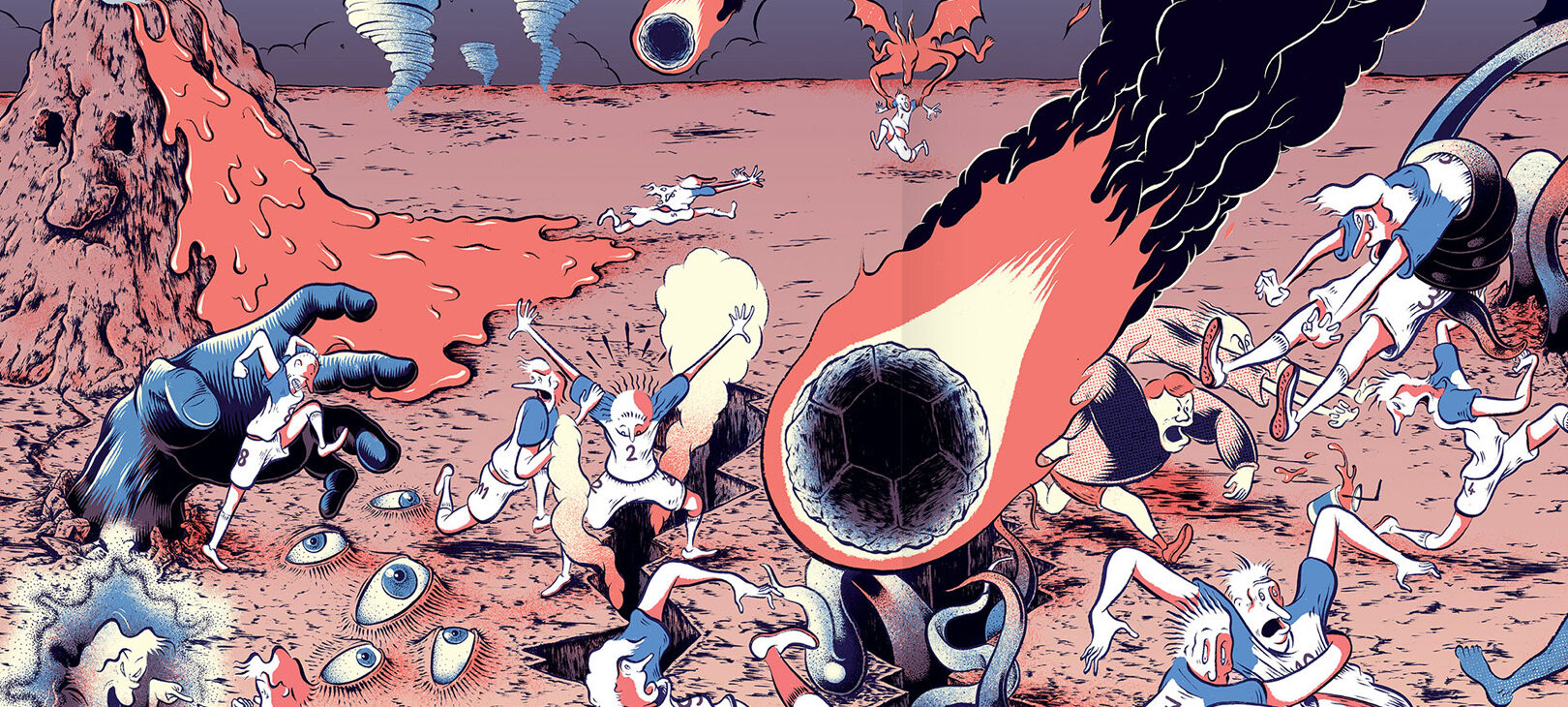
Welcome to your World Cup Winter
November 18, 2022
A reluctant but thorough preview of one of the strangest tournaments ever.
Buckle up and get ready for this year’s edition of a tournament we’ve been raised to love.
A (GROUP A)
While it looks like a walk in the park for the Dutch, each side’s unique style could make every match a tough adjustment. Ecuador’s athletic defenders make them dangerous from set pieces, Qatar will receive the home crowd bump, and AFCON champions Senegal may not have star Sadio Mané but their speedy attackers will cause headaches.
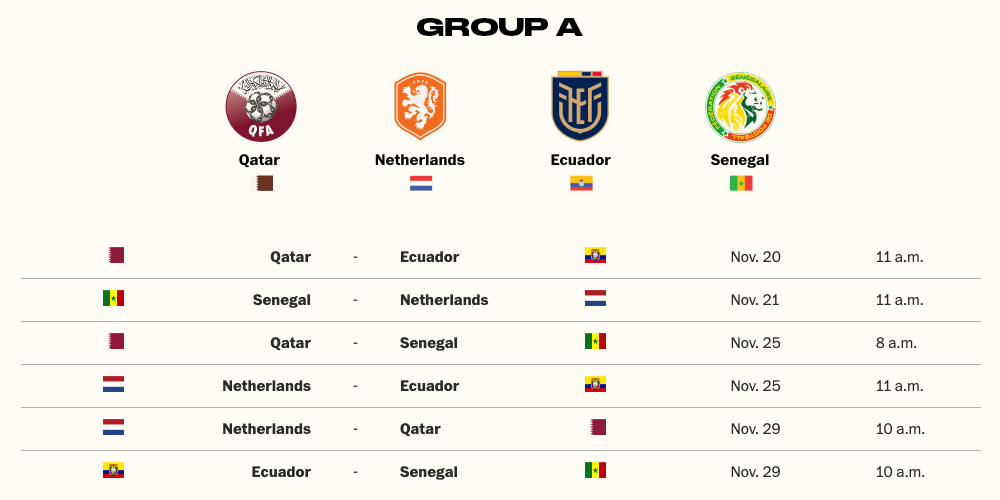
Qatar
The hosts appear in their first ever World Cup ever and while it would be shocking if they make it out of the group, they won’t be embarrassed like many think. In the 2021 CONCACAF Gold Cup they topped their group, knocked out El Salvador in the quarterfinals before falling 1-0 to the US in the semi-final. In 2019 they captured an Asian Cup crown as well. Qatar is led by Spaniard Felix Sanchez Bas, who has been involved in the Qatar coaching ranks for nearly a decade. Recently, Qatar has played a 3-5-2 but it’s really a 5-3-2 for a majority of the game when they sit in a low defensive block. When they do get the ball, you can often see Sanchez Bas’s Spanish influence with organized build-up play unlocking teams with neat passes—but it can look sluggish against superior opposition. While most fans won’t know the Qatar XI, keep your eyes open for creative winger Akram Afif. The GD Chaves man took home the Golden Boot at the Asia and Gold Cup and former manager Xavi speaks highly of him.
Netherlands
After an absence at Russia 2018, the Dutch are managed by the same man who led them in 2014, Louis Van Gaal. They’re fully aboard the three-at-the back train, and why not with options Virgil Van Dijk, Matthijs de Ligt, Stefan de Vrij, and even Nathan Aké. Inter Milan’s Denzel Dumfries plays the right flank perfectly while out left Daley Blind can still give a consistent seven out of ten every match. Despite a lack of major tournament experience, the Netherlands possess the seventh best odds to win the tournament. Rumors swirled of PSV’s Cody Gakpo pushing for a big move this summer, so a great World Cup could be the ignition for a move to European elite in January. the Dutch use Frenkie de Jong perfectly in a playmaking role from deep and count of Memphis Depay as their premier goalscorer.
Senegal
The status of Sadio Mané has been a roller coaster. A damaged fibula in early November, widespread joy when named to the Senegal squad, then sadly three days before the tournament began news arrived the Bayern star will not participate. Mané is to Senegal what Messi or Neymar is to Argentina and Brazil. Still, Senegal have a healthy chance of getting out of the group. The Chelsea tandem Kalidou Koulibaly and Keeper Édouard Mendy along with Leipzig defender Abdou Diallo give confidence keeping the ball out. Going forward, Sadio Mané’s dribbling and pace will be replaced by Watford star Ismaila Sarr and Monaco’s Krepin Diatta. The midfield, however, brings unease. Sure, Idrissa Gana Gueye still can play a role at defensive mid and has the most appearances of anyone in the squad, but who is the ball carrier or facilitator? It could be Pape Matar Sarr, who has gotten little playing time under Antonio Conte at Tottenham but the 20-year-old Sarr has already impressed in five caps in 2022 alone. Along with Morocco, Senegal have the most African talent playing in well-known European leagues.
Ecuador
Ecuador out-qualified familiar South American sides Colombia and Chili to make their fourth-ever World Cup. Ecuador features exciting young defensive personnel: 20-year old Piero Hincapie of Bayer Leverkusen, 23-year-old Byron Castillo from Club Leon, and 24-year-old Pervis Estupinan of Brighton—who played a significant role in Villareal reaching the Champions League semi-final last season. Manager Gustavo Alfaro plays a balanced 4-3-3 with all-time top-goal-getter Enner Valencia still leading the line. Fans are falling for young Real Valladolid winger Gonzalo Plata who has massive potential out left. Ever-active Brighton midfielder Moisés Caicedo will look to boss the midfield and trigger counter opportunities. Watch out for them on set pieces, as 35% of their expected goals came from them in qualifying. A weakness: they draw too many games. At the last major tournament, Copa America 2021, they drew all three matches and have drawn 10 of 29 under Alfaro.
Who Makes it Out: Netherlands and Senegal.
Senegal would become the first African team since Algeria in 2014 to make it out of the group stage.
B (GROUP B)
Every squad seems to have momentum going into the tournament and this group definitely offers geopolitical drama. Recent soccer converts may expect England to crush it at international tournament, before 2018 the Three Lions hadn’t passed the quarterfinals for 24 years.
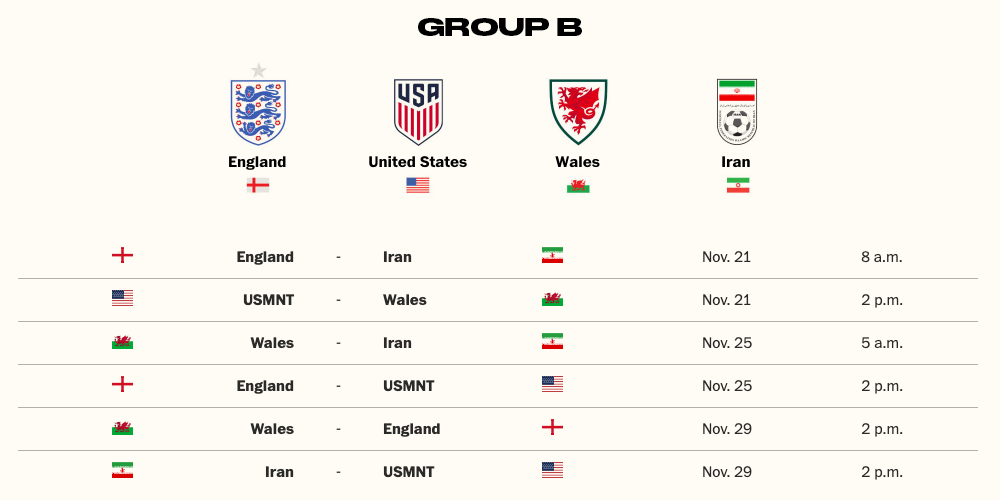
USA
The stench of not making Russia 2018 is still in the room but recent World Cup history before that isn’t as odorous—the US reached the knockout stage in three of the four World Cups between 2002-2014. All the big names are fit and ready to fire: Gio Reyna has struggled with niggling injuries since bursting onto the scene but 20-year-old will be a spark off the bench or start on the opposite flank of Pulisic. Leeds man Brendon Aaronson will likely start out left; the attacking and pressing possibilities between Aaronson and Sergino Dest out right is exciting for USMNT fans. Potential starting midfield trio MMA (McKennie, Musah, Adams) give the US the legs to run with anyone. McKennie often looked like the side’s best player in recent fixtures. The team’s youth is a constant story, but it’s hard to believe Christian Pulisic is still only 24 considering how long he’s been on the scene. “This generation hasn’t yet defined themselves. And we have the opportunity to begin to define ourselves at this World Cup,” said manager Gregg Berhalter on “Men in Blazers.” I slightly disagree with Berhalter considering the core of this side has already lifted two trophies beating Mexico in the most recent Gold Cup and CONCACAF Nations League Final just last year. Lastly, while much was made of Zack Steffen missing out on the 26, the once weak position looks like a strength now with Arsenal’s Matt Turner firmly securing the spot (look what happened to New England’s defense once he left).
Iran
A strength Iran offers that the United States doesn’t is an established goalscoring number nine. Mehdi Taremi is one of the most underrated strikers in Europe. The Porto man has scored 60 goals in 152 Primeira Liga matches while tacking on 32 assists. Other key members of the side include Eredivisie stud Alireza Jahanbakhsh, Leverkusen forward Sardar Azmoun— who is rushing back from injury—and starting keeper Alireza Beiranvand can throw the ball so damn far. Funnily enough manager Carlos Queiroz is only taking 25 players to Qatar when all sides are allowed 26.
Wales
While their 2016 Euro semi-final run was memorable, this is their first World cup since 1958. It’s a nice mix of the old guard with Gareth Bale, Aaron Ramsey, Ben Davies, and even 32-year old Joe Allen—but there’s a healthy amount of players in their early and mid-20s: Dan James, Ethan Ampadu, Neco Williams, Joe Rodon, and Harry Wilson who scored 10 and assisted 19 in the EFL Championship last season. It’s still Danny Ward’s job in goal but he’ll need to gain confidence after a poor first two months as Leicester City’s number-one.
England
The trajectory of the last two major tournaments would say England’s 15th World Cup should be something special. I, like many, question Gareth Southgate’s reliance on such a defensive system with the talent he has. It will be interesting to see if the midfield two from the Euros, Declan Rice and Kalvin Phillips, stays intact or if 19-year-old Jude Bellingham gets the call to start. England easily possesses the most talent in the group with Harry Kane, Raheem Sterling, a red-hot James Maddison, Kyle Walker, and Mason Mount to name a few. Questions still arise: which trio of centerbacks will Southgate fancy? Will leaving Fikayo Tomori out come back to bite? If the tournament was held in the traditional summer window the right-wingback debate would be between Trent Alexander-Arnold and Reece James. Few predicted Kieran Trippier winning the two-horse race but he has been superb for Newcastle, while Alexander-Arnold is in poor form and James is sadly injured. No Jordan Pickford slander should come this tournament, he’s been a rockstar between the posts for Everton.
Who Makes it Out: England and the United States.
It’s an awfully close call but I’ll side with the history of the Americans making it out the group over Wales.
C (GROUP C)
Group C is about Messi and Lewandowski, yes, but there are several Mexican internationals who will say goodbye to international duty after years of quality. History would say Mexico goes through with Argentina, while Poland’s top end talent and experience may launch the European side through.
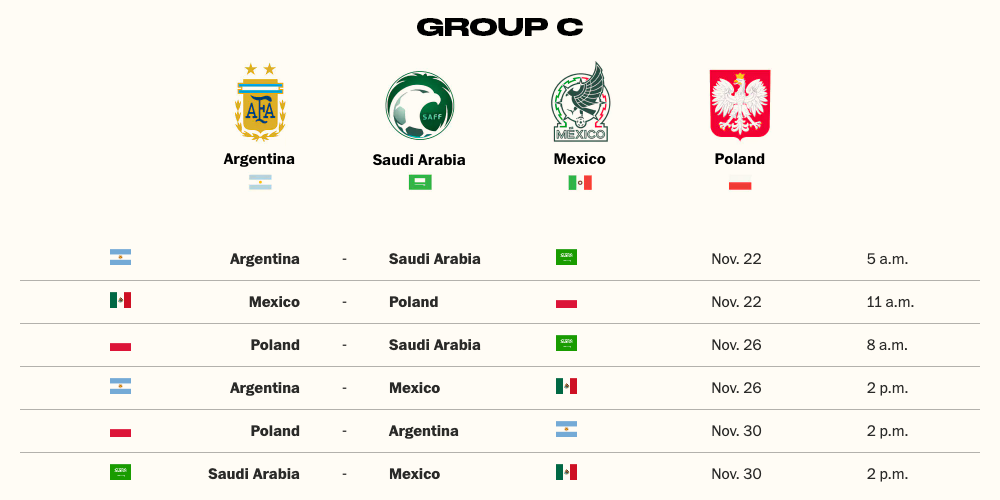
Mexico
Mexico have made every World Cup dating back to USA ’94. They famously have the same destiny every single time: making it to the round of 16 and no further. In 2014 they were 1-0 up in the 88th minute and lost 2-1 in regulation to the Dutch. Mexico was statistically strong in CONCACAF qualifiers, finishing second only on goal differential to Canada—but fans were left uneasy. Jesus Corona, crucial through qualifiers, will miss out through injury. Raul Jimenez returns from a groin issue. It’s slightly surprising Feyenoord’s Santiago Gimenez didn’t make the squad despite being top-scorer in the UEFA Europa League this season. Two of the best-known Mexican players in MLS are not going to Qatar: Chicarito hasn’t played for Mexico in nearly three years because of a strained relationship with manager Tata Martino and Carlos Vela said the 2018 World Cup was his last. Winger Hirving Lozano has been fast-tracked to being the face of the team after blossoming in Italy with league-leading Napoli. And with so much turnover at Ajax it’s been exciting to see midfielder Edson Alvarez turn into a safe pair of boots for the Dutch giants—he’s as good in the air as any midfielder in Europe. This will likely be the last World Cup for longtime internationals Guillermo Ochoa, Andres Guardado, and Houston Dynamo midfielder Hector Herrera.
Poland
Poland put out serious talent in the mid 2010s with Robert Lewandowski, Jakub Błaszczykowski, and Kamil Grosicki leading the attack while Lukaz Pizcek, Kamil Glik and then-Sevilla midfielder Grzegorz Krchowiak were key names on defense. Lewandowski is obviously still the main man but Qatar 2022 sets a stage for a new-look Polish side. Napoli midfielder Piotr Zielinski plays a major role in a more advanced position, Premier League regulars Jan Bednarek, and Matty Cash will all likely start. Grzegorz Krychowiak will be a strong base from which to build. Wojciech Szczesny is a top-class keeper even in a floundering Juventus side, and while manager Czesław Michniewicz may not trust the 20-year-old to start, but Roma wingback Nicola Zalewski always impresses within Jose Mourinho’s Roma side.
Saudi Arabia
Saudi Arabia surprisingly topped their qualification group beating out Japan and Australia to make their sixth World Cup. The Saudi Arabian side heading to Qatar is made up of players solely playing in the domestic Saudi Pro League. Manager Herve Renard is the right man for the job nonetheless—he’s done wonders with lesser national sides, such as winning the African Cup of Nations with Zambia in 2012. Salem al-Dawsari and will be the focal point going forward while solid keeper Mohammed al-Owais will play in his second World Cup—the Saudis only gave up six goals in ten qualification matches. Unfortunately, talented winger Fahad al-Muwallad will miss out on Qatar because of a doping issue in February.
Argentina
Argentina ended a 28-year trophy drought when they defeated Brazil in the 2021 Copa America final, giving hope that Messi could win the most prized piece of silverware this winter. While Argentina has always had plenty of attacking talent over the last decade, this iteration is much more well-rounded. Defenders Lisandro Martinez and Cristian Romero have developed into some of the best central defenders the Premier League has to offer—at the perfect time. Emi Martinez is superior to recent Argentine keepers; midfield strength is also better than 2018 with the likes of Rodrigo De Paul, youthful Enzo Fernandez, Leandro Paredes, and even Alexis Mac Allister—whose face resembles Messi and name resembles a Scotsman. Argentina has the fifth best odds of winning Qatar 2022, which will likely be Messi’s last. Messi is back to Barcelona-form and the winter Cup has been good for their injury situation, except for Giovanni Lo Celso. If you believe in destiny, hitch your wagon to Messi and Argentina.
Who Makes it Out: Argentina and Poland.
I’ll side with the two best players to lead their nations out the group, Barcelona’s best player and their best ever player: Robert Lewandowski and Lionel Messi.
D (GROUP D)
I can’t wait to come back after the group stage to eat my words but Group D is the most predictable. France first, Denmark second, Australia third, Tunisia fourth. Denmark does have the ability to beat France to first—they certainly bested the French in the UEFA Nations League this summer.
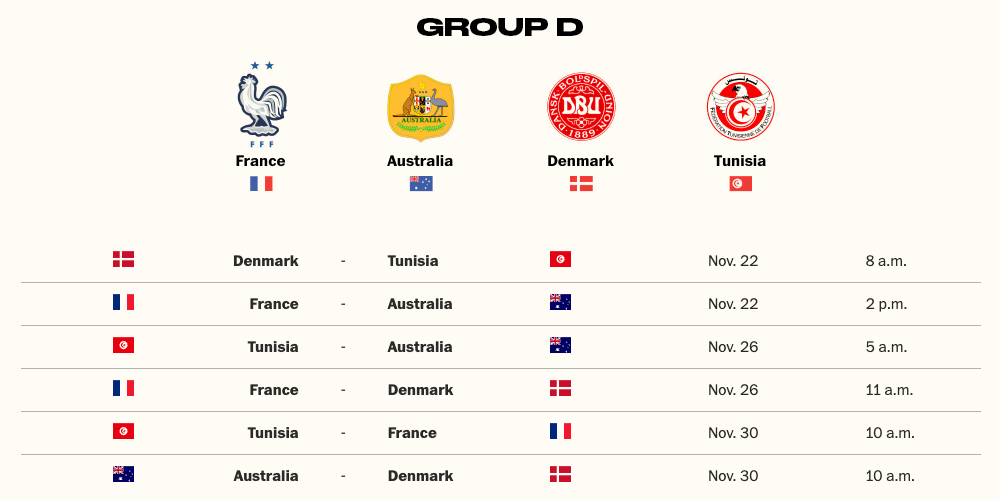
Denmark
Denmark have had an eventful year and a half: from the terrifying Eriksen situation in the summer of 2021, to nearly making the Euro Cup final, then finishing with a European-best 27 points in qualification. In the Euros they played a three-back, but since March of 2022 manager Kasper Hjulmand has usually lined up in a 4-2-3-1. Pierre-Emile Hojbjerg, Thomas Delaney and Christian Eriksen pull the strings in an excellent midfield. The defense features captain Simon Kjaer, Barcelona’s Andres Christian, and underrated Crystal Palace man Joachim Andersen. Going forward is the question mark. Euros standout Mikkel Damsgaard has only earned 267 minutes for Brentford since signing this summer, wide man Andres Skov Olson is having a strong season for Club Brugge, while Kasper Dolberg faces strong competition from Andreas Cornelius for the starting number-nine role.
Australia
The Aussies qualified for their sixth consecutive World Cup via playoff penalties when veteran keeper Andrew Redmayne broke Peruvian hearts over the summer. The Socceroos have only ever made it out the group in Germany 2006 but have a chance this winter with the second-oldest side at Qatar 2022. The squad features Copenhagen goalkeeper Mathew Ryan, fan favorite Aaron Mooy, Melbourne City star striker Jamie Maclaren—who has scored 70 goals in 77 A-League games since 2019. Mathew Leckie, will bring his Bundesliga pedigree to the left side of attack. Manager Graham Arnold lines up his side in a 4-2-3-1. This Australia side is not as strong as 2018 or 2014, and they’re not helped by Australian-born Roma teenager 18-year-old Cristian Volpato rejecting the Socceroos’ World Cup call as he’s aiming to represent Italy.
Tunisia
Tunisia has won only two games in World Cup history: their first ever World Cup match against Mexico in 1978 and their most recent World Cup game, a 2-1 victory over Panama in 2018. They’re led by new manager Jalel Kadri who got his side to the World Cup after defeating Mali in a playoff. Tunisia plays a 4-1-4-1 and like to frustrate their opponents rather than playing more organized and precise soccer. They had a disappointing African Cup of Nations performance being knocked out by Burkina Faso but Qatar 2022 gives stage to a fun midfield trio of talented Manchester United 19-year old Hannibal Mejbri, the familiar Wahbi Kazri—who probably plays too far forward to even be considered a midfielder—and Köln defensive mid Ellyes Skhiri.
France
The defending champions look to become the first nation since Brazil in 1962 to become repeat winners. France have the most talent in the world but it’s more a question of how manager Didier DeChamps lines up his side. Four of the starting 11 from 2018 are not in the squad for 2022 and the midfield will need the most chopping and changing with regulars N’Golo Kanté and Paul Pogba missing through injury. It’s an alright problem to have when a pair of Rolls Royce Real Madrid midfielders show up in Eduardo Camavinga and Aurélien Tchouaméni. Elsewhere Pavard and Theo Hernandez will start at the fullback spots while Deschamps has to pick the best of Kimpembe, Varane, Konate, Kounde, Saliba, and Upamecano. In recent fixtures the French flirted with a three-back formation, it could allow for three of the star central defenders to start. Up top, it’s just two of the five best attackers in the world with Karim Benzema back and PSG superstar Kylian Mbappe. If this was a video game they’d have the highest rated team, but they’ve only won a single game in six UEFA Nations League contests, including two losses to groupmates Denmark. At the 2020 Euros, France embarrassingly collapsed with 3-1 lead in the final ten minutes of the 90, eventually losing on penalties to Switzerland. Given all that, the depth France maintains year after year makes them favorites or near to it every World Cup.
Who Makes it Out: France and Denmark.
Talentwise, the two European sides are far superior to Tunisia and Australia. Then again you could always be Costa Rica in 2014.
E (GROUP E)
The only group at this iteration of the World Cup that features two nations who have lifted the trophy: Germany and Spain. Beyond that, all four sides bring up memories even your casual soccer bud will remember: Spain won three major tournaments in a row (Euros in 2008, ’12 and the 2010 World Cup) with an obscene wealth of talent; Germany of course with the Mario Götze goal in the 2014 final; and Costa Rica topped a group featuring Uruguay, Italy, and England in 2014. As for Japan, they lost a thrilling 3-2 contest to Belgium after leading 2-0 in the knockout round in Russia.
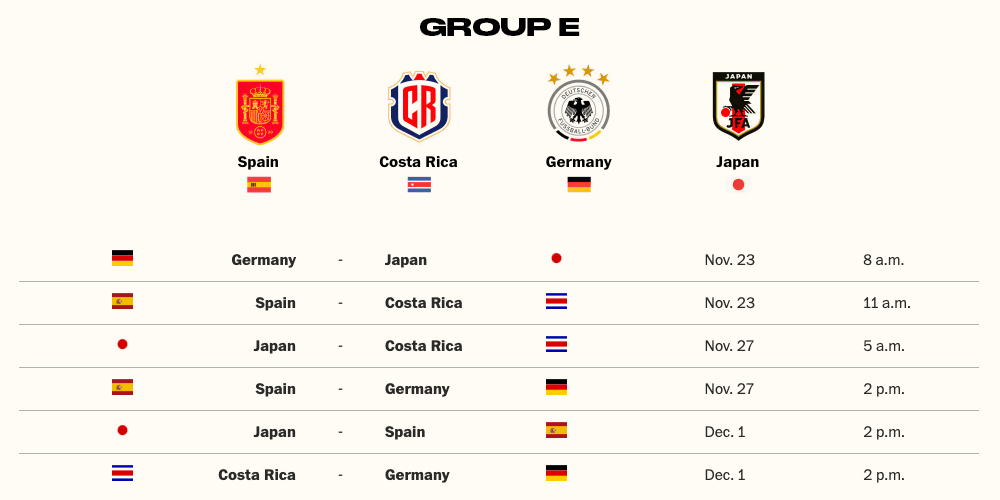
Spain
Spain have won just two total World Cup matches since winning the trophy in South Africa 2010. It wasn’t helped by the complicated manager debacle in 2018 when Julian Lopetegia was fired just days before the World Cup. Spain topped their UEFA qualification group going 6-1-1 with former Barcelona manager Luis Enrique lining up in an identifiable 4-3-3. Sadly gone are the days of Inesita, Xavi, Cesc Fabragas, Iker Casillas, David Villa and company but there are reasons the Spanish should be optimistic. Spain may have the best midfield depth in the world—it’s so good Liverpool’s Thiago didn’t even make the team. Enrique has to figure which three work best together: Busquets and the teenage duo of Gavi and Pedri certainly have chemistry from Barcelona—but inserting Marcos Llorente or Rodri would pay dividends defensively. It feels like De Gea’s Spain career is finished with him not making the 26, so Unai Simon will likely start. Finally, the forwards, aren’t up to typical Spain standards. None of the eight forwards Spain are sending to Qatar are considered stars (yet); of the 17 league goals they have scored so far season, five are from Alvaro Morata. Spain’s backline is experienced, great on the ball, and can carry them to results when the offense isn’t firing.
Japan
In 2018 Japan got through group H on yellow cards. No really. Tied on points, goal differential, goals scored, and head-to-head, the Japanese squeaked through via the “fair play tiebreaker” over Senegal. Manager Hajime Moriyasu has more European based talent to lean on at Qatar 22. Monaco attacker Takumi Minimino led the team with 10 goals in qualifying, Kaoru Mitoma has featured well at Brighton this season, Takefusa Kubo hasn’t completely lived up to the hype but is still a talented dribbler, while recent standout Junya Ito could get the start after his exploits in Belgium last season and with Reims this year. The midfield features a Bundesliga duo, Daichi Kamada and Wataru Endo. It was a rather large surprise that Celtic’s maestro, Reo Hatate, could not get in the squad for Qatar, but the decision could speak to the strength Hajime Moriyasu believes he has in midfield. Defensively, a partnership of Sampdoria’s Maya Yoshida and Arsenal’s Tomiyasu looks formidable, despite Tomiyasu struggling with injury.
Germany
Germany enter a major tournament for the first time since 2006 without manager Joachim Lowe, but the team looks ready: Since losing to England in last summer’s Euros, the Germans sliced through World Cup qualifying and the UEFA Nations League with 18 wins, five draws, and just two losses. In those 25 games they scored 81 times. Qatar 22 will feature familiar faces like Joshua Kimmich, Ilkay Gundogan, Manuel Neuer, Thomas Muller, and—surprisingly—2014 hero Mario Gotze was included. New faces have been given recent opportunities as well. Nico Schlotterback and Lukas Klostermann have played a solid role defensively, but the question is who starts with star Antonio Rudiger? Big-name attackers like Serge Gnabry, Leroy Sane, and Kai Havertz will all be playing in their first World Cups, but they seem like established veterans at this point. There’s real youth talent in this German side: 17-year-old Youssoufa Moukoko was named in the 26 and if he plays it will be his first-ever German cap; 20-year-old Karim Adeyemi is versatile across the front line; the real jewel is 19-year-old Jamal Musiala, who’s quickly approaching world-class status for Bayern.
Costa Rica
Like Germany, Costa Rica had success in 2014 topping their group and heroically winning a knockout game. Also like Germany, they didn’t get out of the group in 2018. Manager Luis Fernando Suarez, who took over in 2021, has made great early impressions. The Ticos went unbeaten in their final eight qualification games to make Qatar. Despite being over eight years ago, similar players line up for Costa Rica now as they did in their successful 2014 run. The two all-time Costa Rican cap holders—34-year-old Celso Boreges, and 36-year-old favorite Bryan Ruiz—will both likely start in Qatar. Fellow longtime internationals Keylor Navas in net and former Arsenal forward Joel Campbell in attack always pop up for their Central American country as well.
Who Makes it Out: Germany and Spain.
Both giants experienced serious World Cup hangovers (Spain in ’14, Germany in ’18) but the pressure has eased, at least enough for them to make it out of the group.
F (GROUP F)
The “Darling Group.” If you’re a soccer fan there’s a good chance you like everyone here. Canada are playing in their first World Cup in 36 years with numerous MLS players, Croatia were the lovable dark horse in 2018, Belgium was everyone’s favorite hipster team in the early/mid 2010s, and Morocco are searching to get out of the group for the first time since Mexico 1986…after being one of the first teams to truly get their heart broken by VAR in Russia four years ago.
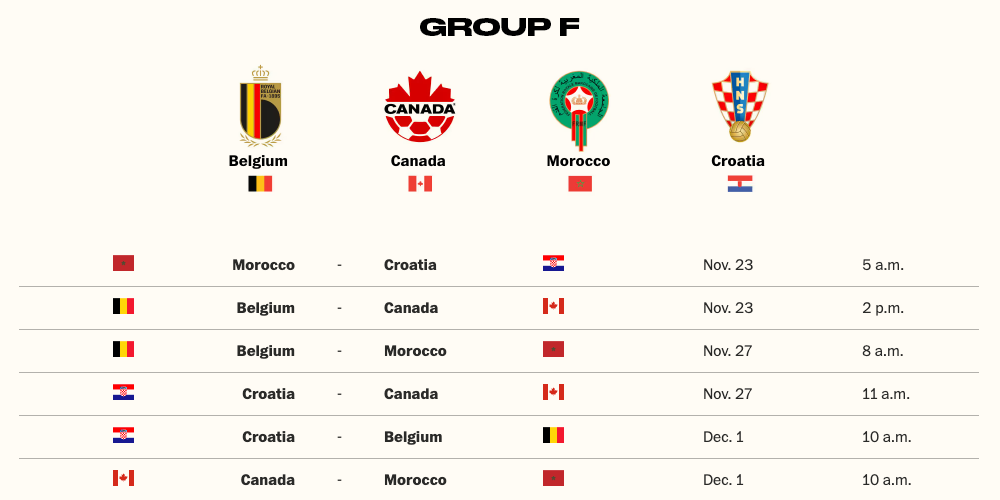
Belgium
Belgium achieved their best World Cup finish ever in 2018, grabbing third over a heartbroken England. The golden generation fans fawned over in the mid 2010s is certainly waning; mainstays like Eden Hazard, Jan Vertonghen, Toby Alderweireld, and Axel Witsel will likely still feature in the starting XI but are all well into their 30s. Belgium are the oldest European side at Qatar 22. Nonetheless, criticism of manager Roberto Martinez has hushed as the Spainard heads into his third major tournament in charge. The Red Devils breezed through qualification in large part to two of the world’s best: Champions League Final hero Thibaut Courtois and Manchester City’s Kevin De Bruyne. Eyes are off Belgium as a sexy dark-horse pick, and maybe that’s the perfect spot for a team that knows who they are better than anyone else and just happens to be second behind Brazil in the FIFA World Rankings.
Morocco
Qatar 22 will be Morocco’s sixth ever World Cup. While they couldn’t escape tricky Group B in 2018—only because of stoppage-time goals for Iran and Spain—Morocco still impressed. They followed that up with a not-so-impressive AFCON tournament in 2021, crashing out to Mo Salah’s Egypt side. The star players are easy to spot. PSG’s Achraf Hakimi may be the best attacking fullback in the world. Chelsea’s Hakim Ziyech can get Morocco a goal from anywhere in the attacking third with a wand of a left foot. New Bayern defender Noussair Mazraoui travels to Qatar after rejecting a call-up back in March. New manager in Walid Regragui is a major reason Ziyech and Mazraouri are back in the squad, but the former Moroccan international as he has never coached outside of the Moroccan top flight outside of a season with Al-Duhail in Qatar. Keep an eye on QPR midfielder Ilias Chair off the bench, who has shone in the Championship this year. He’ll wait behind Sevilla striker Youssef En-Nesyri or Angers winger Soufiane Boufal, but he’s a breakout possibility.
Canada
Hard not to root for, even for an American. While they went without superstar Alphonso Davies for much of qualification, Canada notably went unbeaten against the US and Mexico to top CONCACAF. Canada’s only other World Cup was Mexico 1986 where they finished dead last and scoreless. That absolutely should not be the case this time with forward play a strength: Cyle Larin, who always performs for his nation—scoring 25 in 54 caps—and Jonathan David, who can’t stop scoring for Lille (seriously, look at his numbers the last four seasons in Europe). While just reaching this point is a victory for Canada, John Herdman’s rock and roll style and top-end talent could surprise the other three in Group F. It will be interesting to see what formation they elect to play but a few things are certain: Alphonso Davies is awesome and will play a more advanced role, all-time cap holder (97) Atiba Hutchinson will still be a rock in midfield at 39 years old, and unfortunately we won’t see keeper Milan Borjan rock sweatpants if he gets the start in the Qatari heat. 10 of the 26 in Canada’s squad hail from the MLS.
Croatia
2018…was fun. Reaching the final in Russia won Luka Modrić a Ballon d’Or; their defeat to the French took nothing away from a special run. The encore wasn’t superb in the 2020 Euros—Croatia won only a single contest over Scotland and got dumped in the first knockout round to Spain. Five of the 11 starters from the 2018 final are missing from the 2022 squad. The two biggest omissions are Ivan Rakitić and Mario Mandžukić, who both retired from international play. Manager Zlatko Dalić’s 4-3-3 engine room of Modrić, Mateo Kovačić, and Marcelo Brozović is balanced, experienced, and as brilliant as any midfield at the tournament. Croatia may need to lean on youth elsewhere though. 20-year-old Center back Josko Gvardiol is being chased by Europe’s elite and will likely start—inflating a transfer fee to near 9-digits if he delivers. There isn’t a name that screams goals. Tottenham’s Ivan Perišić will play in attack instead of wingback as he does for Antonio Conte, Mario Vlašić has had a strong season with Torino after a failed stint with West Ham, and look out for strong and speedy Mislav Oršić who always shows up against strong competition in the Champions League for Dinamo Zagreb. Oh yeah—everyone’s favorite, Dejan Lovren, is still around and could start in the backline.
Who Makes it Out: Belgium and Croatia.
This group has the most upset potential. Nonetheless, let’s see Canada win a World Cup game before we project them for the next round.
G (GROUP G)
These teams know each other well, real well. Brazil, Serbia, and Switzerland were all in Group E together in Russia 2018 and it made for some of the games of the tournament. Serbia vs. Switzerland, a match I attended, was surrounded with geopolitical controversy as Granit Xhaxa and Xherdan Shaqiri each flashed support for Kosovo after scoring against the Serbs in Kaliningrad. Oh, and a stacked Brazil side look to become the first South American team to win the trophy since they won it 20 years ago.
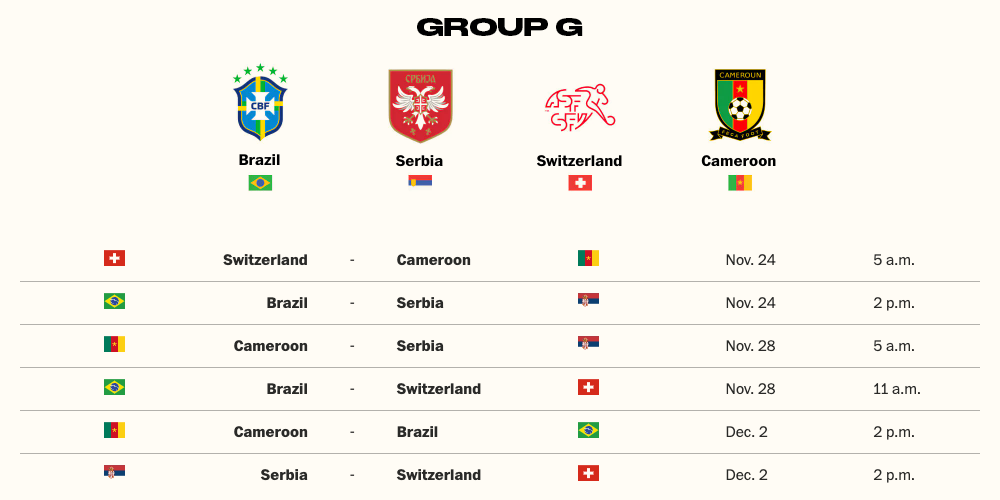
Serbia
Serbia missed out on last summer’s Euros, but Yugoslavian midfield maestro-turned-manager Dragan Stojković has a squad littered with familiar European talent, especially its Serie A bunch: Filip Kostić, Sergej Milinković-Savić, Luka Jović, and 22-year-old Dušan Vlahović—who’s already has a healthy goal return in his young international career. Serbia plays variations of a three-back to make room for more attacking talent featuring captain Dušan Tadić and Fulham striker Aleksandar Mitrović. Going forward this side has way too much attacking talent not to be second favorites in the group behind Brazil but defensively no one screams “you can’t dribble past me.” It could make for some fun games. If only Serbia could make retired standouts like Nemanja Matić, Aleksandar Kolarov and Branislav Ivanović each 10 years younger.
Switzerland
Unlike Serbia, Switzerland surpassed expectations at Euro 2020, knocking out France in dramatic style then narrowly losing out to Spain. The Swiss have made it out of the group stage in three of the last four World Cups and they topped their UEFA qualifiers group over Italy. The attack is still headlined by Xhedian Shaqiri, who is over the century mark for international appearances while making a boatload of money with the Chicago Fire. The strength is the midfield: captain Granit Xhaxa seems rejuvenated for league-leaders Arsenal and Chelsea loanee Denis Zakaria should supplement the side along with regulars Djibral Sow and Remo Frueler. Yann Sommer is in top form, making a Bundesliga record 19 saves against Bayern in September. While not sexy names, the Swiss have excellent centerback options: Manuel Akanji has looked great for Manchester City since signing in the summer, Fabian Schar has been given second life Newcastle, and Nico Elvedi has started nearly every game for Borussia Mönchengladbach since 2015, when he was 18 years old.
Brazil
Brazil are the only nation to have appeared in every single World Cup. First and foremost, Neymar has speculated this could likely be his final World Cup—man does time fly—and manager Tite will not have an easy job deciding who starts alongside him. Vinicius Jr, Richarlison, Gabriel Jesus, Raphinha, Antony, Gabriel Martinelli, and Rodrygo will all compete for the remaining three attacking spots. Importantly, who will start alongside Casemiro in Brazil’s midfield? While some are blinded by Casemiro’s poor start in Manchester, he has been great lately. Does his United teammate Fred start or does the all-action Newcastle man Bruno Guimarães step up in his first major tournament of many. Central defenders are strong for Brazil—but if there’s a weakness it’s likely the fullbacks with Danilo or Dani Alves on the right with Alex Telles or Alex Sandro on the left all (possibly) past their primes. According to VegasInsider, Brazil has the best odds to win the World Cup at five to one.
Cameroon
Cameroon is back after missing out on Russia 2018 and are looking for its first World Cup win since 2002. They got here after topping Group D over the Ivory Coast and then advancing past Algeria in a playoff. The experienced attacking trio of Bayern’s Eric Maxim Choupo-Moting, Vincent Aboubakar, and Lyon winger Karl Toko Ekambi will be responsible for goal output while other standouts in include Napoli midfielder Frank-Zambo Anguissa who likes to drive through midfield and 26-year-old Inter keeper Andre Onana. MLS fans, watch for Seattle’s Nouhou Tolo to start and use his physicality to try to stop the elite attackers of Brazil and Serbia.
Who Makes it Out: Brazil and Serbia.
Brazil is an easy pick—along with the French they have the most talent in the World. In Serbia’s case, their attacking talent is stronger than any other non-Brazilian unit in Group G.
H (GROUP H)
Revenge and final chances. Suarez’s handball off the line against Ghana in the 2010 quarter-finals. South Korea manager Paulo Bento amassed 35 caps for Portugal and managed his homeland from 2010-2014 before getting the boot when a pesky American side finished above them in 2014’s Group G. And the final shot (surely) for Cristiano Ronaldo, who’s trying to escape his hellish domestic season and become idolized by the masses once again.
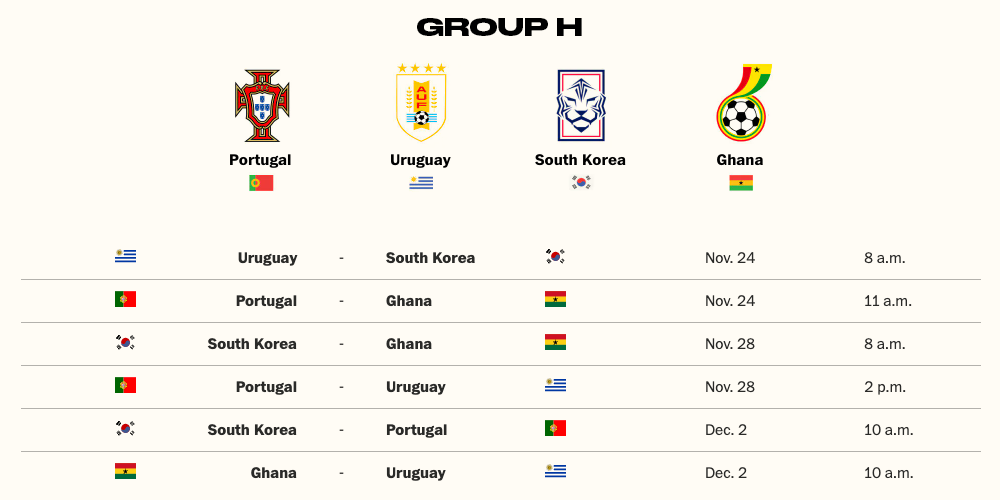
South Korea
South Korea have now qualified for the last 10 World Cups but at the last four they have only won a total of three games. Of course the side is headlined by Heung Min Son, who will be available even after suffering an orbital fracture. If Son scores in Qatar, his third World Cup, he will be top-three in Korean history for national team goals. Paulo Bento’s side breezed through qualification, losing just once in 16 matches. In recent friendlies, South Korea has played a 4-1-4-1 with September Serie A player of the month Kim Ming-Jae (Napoli) leading the backline, Lee Jae Sung (Mainz 05) commanding the midfield, and Wolves forward Hwang hee Chan aiding Son in attack. Lee Kang-In is a tremendous weapon advancing the ball for Mallorca in La Liga.
Uruguay
Uruguay gained automatic qualification in CONMEBOL but it wasn’t easy going just 8W-4D-6L. The nation of less than 3.5 million is one of five countries to have won the World Cup twice and all-time top scorers Luis Suarez and Edison Cavani would love to make it three in their final opportunity. All-time cap holder Diego Godin will likely partner his former club teammate José Giménez with LA Galaxy defender Martín Cáceres as cover. It isn’t all veterans, with a youthful midfield of Rodrigo Bentancur, who’s in blistering form for Tottenham, and Real Madrid’s Federico Valverde. Rushing back from injury, Barcelona’s Ronald Araújo seemingly will never get to play his preferred center-back position as he’s likely pushed to fullback just as club manager Xavi does with him. Then there’s mega-money Liverpool signing Darwin Núñez—who’s started less than half of Uruguay’s matches in 2022. Can you play three conventional strikers together?
Portugal
Perhaps the most soccer-crazed nation never to reach a World Cup final, Portugal possess the eighth best odds to win the tournament in Cristiano Ronaldo’s final try. The Portuguese have failed to win more than one game at a World Cup since 2006 but this year’s side certainly has the talent to go far. Manager Fernando Santos, who’s been in charge since 2014 and famously won the 2016 Euros, exclusively plays a 4-3-3. Compare current talent to that which won the Euros six years ago and it’s an embarrassment of riches. Diogo Jota will miss the tournament through injury but Ronaldo, Rafael Leão, Bernardo Silva, and João Félix will certainly be strong in the. attack. Bruno Fernades, Rúben Neves, and either Paulinha or Carvalho will feature in the midfield, and Rúben Dias, João Cancelo, and Nuno Mendes are excellent at the back. It’s certainly a tournament to shine for Portugal with a meld of the young and new generations.
Ghana
Ghana’s qualification was closer than any other. Going down to the third tie-breaker with South Africa in the group, then qualifying for the tournament over Nigeria on away goals. Ghana are labeled with the lowest current FIFA ranking in the tournament, but they certainly have talent. Premier League regulars are littered across the side with Arsenal midfielder Thomas Partey having his best season in years, Andre and Jordan Ayew, young Southampton defender Mohamed Salisu, Ajax’s Mohammed Kudus, Celta Vigo’s Joseph Aidoo amongst others. Former player Otto Addo was named manager in February and in recent friendlies he’s gotten notable players to switch nationalities, such as like Tariq Lamptey and dangerous forward Inaki Williams.
Who Makes it Out: Uruguay and Portugal.
While recent Ronaldo drama could derail Portugal, he isn’t the lifeblood of the team like he used to. I do worry about the lack of wide attacking talent for Uruguay, but the team is too good and experienced everywhere else.

Contributors
Adam Susman
Recent College grad of the University of Oregon. Formerly in sports radio at 750 The Game working closely with the Timbers before moving to Howler. Voice of University of Portland Men’s Soccer, PDX FC, former voice of University of Oregon Women’s Soccer. Once called the Gareth Bale of pickup soccer.
Renaud Vigourt
Renoud’s muralesque epic ran in Howler 14 along with a piece on the USMNT’s failure to qualify for Russia 2018. Things are better now…but somehow it still works. Renaud Vigourt is an illustrator working and living in Besançon, France. Follow Renaud on instagram.
TAGS